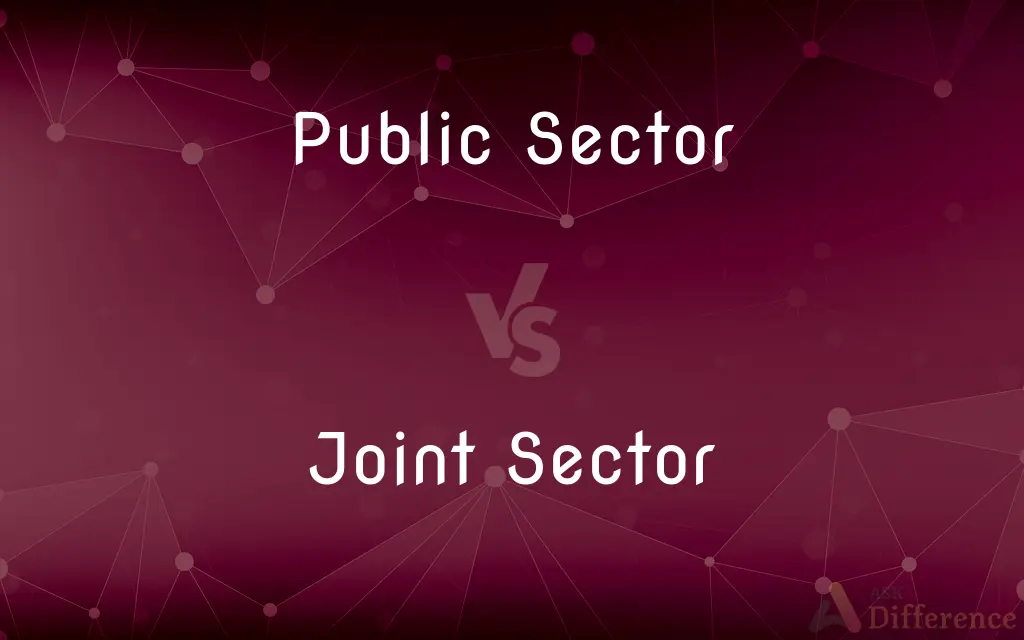Public Sector vs. Joint Sector — What's the Difference?
By Tayyaba Rehman — Published on January 28, 2024
The public sector is owned and operated by the government, focusing on public services, while the joint sector involves government partnership with private entities for business ventures.

Difference Between Public Sector and Joint Sector
Table of Contents
ADVERTISEMENT
Key Differences
The public sector encompasses organizations owned and operated by the government. It primarily focuses on providing essential public services like healthcare, education, and infrastructure. The joint sector, however, represents a collaborative venture where both the government and private sector partners share ownership and management responsibilities.
Public sector organizations are funded by the government and are accountable to the public and legislative bodies. In contrast, joint sector enterprises are financed through a combination of government and private investment, with accountability mechanisms often blending public oversight and private sector efficiency.
The decision-making process in the public sector typically follows bureaucratic procedures and is driven by public policy objectives. In the joint sector, decision-making can be more dynamic, incorporating both government directives and private sector business strategies.
Employment in the public sector often offers job security and is governed by standardized pay scales and benefits. The joint sector may offer a more competitive and performance-oriented work environment, influenced by its private sector involvement.
The public sector's primary goal is to provide services for the public good, often without profit motives. The joint sector, while also possibly serving public interests, aims to be financially viable and profitable, reflecting its private sector partnership.
ADVERTISEMENT
Comparison Chart
Ownership
Government-owned and operated
Government and private sector partnership
Funding
Government funding
Combination of government and private investment
Decision-Making
Bureaucratic, public policy-driven
Blend of public oversight and private efficiency
Employment Structure
Job security, standardized benefits
Performance-oriented, competitive
Primary Objective
Public service, often non-profit
Financial viability and profitability
Compare with Definitions
Public Sector
Government-owned and operated organizations.
The public sector plays a key role in providing essential services.
Joint Sector
Combines public accountability with private efficiency.
The joint sector model brings efficient management to public projects.
Public Sector
Often provides job security and standardized benefits.
Many choose public sector employment for its job stability.
Joint Sector
A collaboration between government and private businesses.
The joint sector project combines public oversight with private innovation.
Public Sector
Funded and managed by government resources.
Public sector funding is essential for maintaining infrastructure.
Joint Sector
Aims for both public service and profitability.
Joint sector ventures can be financially successful while serving the public.
Public Sector
Operates to serve the public interest.
Public sector initiatives are driven by the community's needs.
Joint Sector
Funded by both government and private investments.
Our joint sector initiative received funding from both government and private investors.
Public Sector
Focused on public services like healthcare and education.
Public sector hospitals are crucial for accessible healthcare.
Joint Sector
Offers a dynamic approach to decision-making.
Decision-making in our joint sector company is agile and innovative.
Common Curiosities
How is the joint sector beneficial for the economy?
It brings together government support and private sector efficiency.
What types of projects are common in the joint sector?
Infrastructure projects, technology ventures, and energy sector collaborations.
What is the main aim of a joint sector venture?
To be financially viable while potentially serving public interests.
What services are typically provided by the public sector?
Services like education, healthcare, and public transportation.
Can public sector organizations be profitable?
They mainly aim for service provision, not profit.
How is funding allocated in the public sector?
Through government budgets and taxpayer money.
Can private entities influence public sector decisions?
Public sector decisions are generally driven by public policy, not private interests.
Do public sector organizations face competition?
They may face limited competition due to their unique role in public service.
Are joint sector employees government employees?
Not necessarily; employment terms depend on the specific partnership agreement.
Is customer service a focus in the public sector?
Service quality is a focus, though it may differ from private sector standards.
How is performance evaluated in the joint sector?
Through a mix of public service benchmarks and business performance metrics.
Are public sector jobs well-paid?
Pay scales vary, but they generally offer stability and benefits.
Are joint sector ventures common worldwide?
Yes, they're increasingly common in various economies for strategic development.
Can a joint sector company be listed on the stock market?
Yes, if the partnership structure allows for it.
What is the role of government in a joint sector?
To provide oversight, funding, and sometimes policy direction.
Share Your Discovery

Previous Comparison
Condenser vs. Heat Exchanger
Next Comparison
Veneer Grafting vs. Side GraftingAuthor Spotlight
Written by
Tayyaba RehmanTayyaba Rehman is a distinguished writer, currently serving as a primary contributor to askdifference.com. As a researcher in semantics and etymology, Tayyaba's passion for the complexity of languages and their distinctions has found a perfect home on the platform. Tayyaba delves into the intricacies of language, distinguishing between commonly confused words and phrases, thereby providing clarity for readers worldwide.
















































